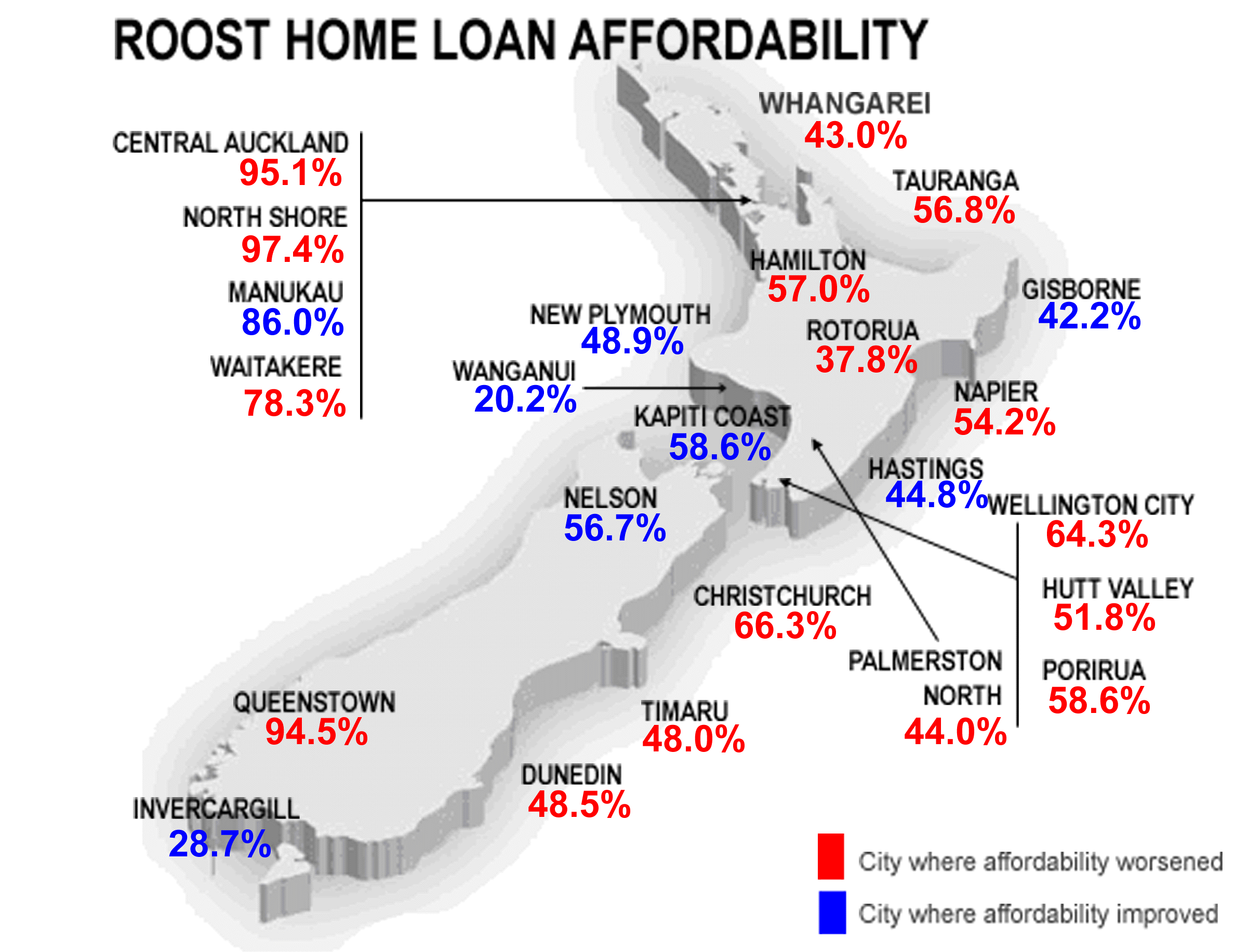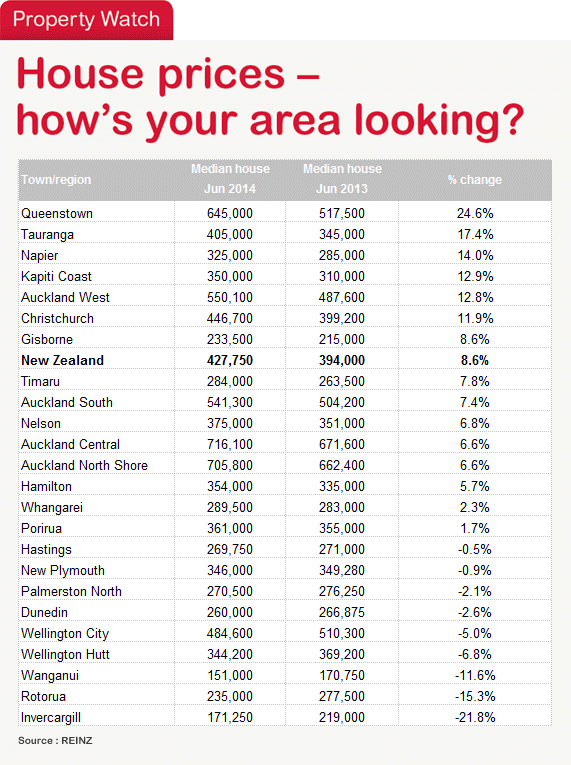
Home loan affordability worsened slightly across most of New Zealand in May as a rise in interest rates more than offset a small fall in median house prices.
The Roost Home Loan Affordability Reports showed a deterioration in 16 of 24 regions, including on the North Shore of Auckland, which reclaimed the title of the being the least affordable area for first home buyers in New Zealand.
A 0.5% fall in the national median house price in May from April was not enough to compensate for the two increases in the Official Cash Rate in March and April. Advertised floating mortgage rates rose almost half a per cent to around 6.25% in the first six months of 2014. They have since risen another 0.25%.
The Roost Home Loan Affordability reports showed improvements in the month in 8 of the 24 regions measured. The Roost reports have been referred to repeatedly in and out of Parliament in recent months as the debate over housing affordability heats up before the September 20 election.

Banks have been more aggressive in recent months in offering cut-rate longer-term fixed mortgage rate deals, passing on the benefits of low international and local funding costs. Average two year fixed mortgage rates fell 13 basis points to almost 6% in May, taking two year rates well below floating rates on 6.25% by the end of May. Floating rates have since risen to around 6.5%.
"The shift in longer term fixed rates to substantially below floating rates has changed the landscape for borrowers," said Roost Home Loans spokeswoman Colleen Dennehy. "Talking to a mortgage broker can help a borrower consider their options, and get the best deal out of a bank," Dennehy said.
The Roost Home Loan Affordability reports show national affordability deteriorated to 63.1% in May from 62.5% in April after the national median house price fell to NZ$432,000 from NZ$432,250 and the average floating mortgage rate rose to 6.23% from 6.05% a month earlier.
The Roost Home Loan Affordability reports for May showed affordability for regular home buyers worsened in 16 cities and regions, including Central Auckland, Whangarei, Tauranga, Hamilton, Wellington City, Christchurch, Dunedin and Queenstown. But they improved in Manukau, Gisborne, New Plymouth, Nelson and Invercargill.
It was toughest for first home buyers on the North Shore of Auckland, which reclaimed its mantle as the most expensive area relative to incomes from Manukau in April. It took 109.9% of a single median after tax income to afford a first quartile priced house on the North Shore, up from 103.1% the previous month.
Housing affordability has become a major economic and political issue over the last 18 months. The Reserve Bank and Government agreed on a toolkit of 'macro-prudential' controls a year ago that would see the central bank impose limits growth in high LVR mortgages and force banks to hold more capital. Central and local governments are also moving to address housing supply shortages. The Reserve Bank's speed limit was applied on October 1 and it said in its June Monetary Policy Statement it appeared to have worked to reduce house price inflation by around 2.5 percentage points.
For first home buyers – which in this Roost index are defined as a 25-29 year old who buys a first quartile home – there was a worsening in affordability in 13 of the 24 regions covered and the national measure also worsened.
It took 51.3% of a single first home buyer's income to afford a first quartile priced house nationally, up from 51.2% a month earlier. The most affordable city for first home buyers was Wanganui, where it took 19.7% of a young person's disposable income to afford a first quartile home. The least affordable was North Shore at 109.9%.
Any level over 40% is considered unaffordable, whereas any level closer to 30% has coincided with increased buyer demand in the past.
For working households, the situation is similar, although bringing two incomes to the job of paying for a mortgage makes life considerably easier. A household with two incomes would typically have had to use 41.4% of their after tax pay in May to service the mortgage on a median priced house. This is up from 41.0% the previous month.
On this basis, most smaller
For first-home buying households in the 25-29 age group (which are assumed to have no children), affordability nationally worsened to 24.9% of after tax income in households with two incomes required to service the debt, up from 24.8% the previous month. The lower quartile house price fell to NZ$287,000 from NZ$290,000 the previous month.
Any level over 30% is considered unaffordable in the longer term for such a household, while any level closer to 20% is seen as attractive and coinciding with strong demand.
First home buyer household affordability is measured by calculating the proportion of after tax pay needed by two young median income earners to service an 80% home loan on a first quartile priced house.
---------------------------------------------------------------------------------------------------------------------------------------
Mortgage choices involve making a significant financial decision so it often pays to get professional advice. A Roost mortgage broker can be contacted by following this link »
---------------------------------------------------------------------------------------------------------------------------------------
No chart with that title exists.
Full regional reports are available below:
1 Comments
Great article, also with increases next month in Timber, Concrete , Tin and Glass the cost of construction for any new Home will rise.
Councils generally rise the regulatory costs in July, when they analize rates increases etc.
Building Permits increase, Resource Consent Applications rise, so a few more general increases to slap onto a new home.
with the historic low interest rates dwindling and higher rates on the horizon developers are rethinking future projects, Shelving them.
if someone thinks houses are expensive just wait six months and they will be even more unatainable.
unless New Zealand builds 30,000 homes a year, not talk about it actually build with hammer and nails, no more reports about building actually build houses then it can only get worst with general population growth and immigration that exceeds dwelling construction.
in most areas with new housing accords the infrastructure ,Sewers, water, telco wont handle the extra load with out massive investment,,,when you make a massive investment you need a massive return, so no affordability there.
so you must look at countires that dont have an affordability issue,,,what mechanisms are in place there to increase home ownership, simple stuff, you could cut and paste most of it, but then we do like to form a committee or working group here and councils love to be part of it all, but councils dont build houses nor do committees.
Now Govt want to review -analize previous reports like home and housed etc, you can only kick a can so far down the road.
the ratings agencies arent silly nor the UN. NZ signed the accord, Food, Medicine and Shelter and it seems we are running out of shelter....



We welcome your comments below. If you are not already registered, please register to comment.
Remember we welcome robust, respectful and insightful debate. We don't welcome abusive or defamatory comments and will de-register those repeatedly making such comments. Our current comment policy is here.